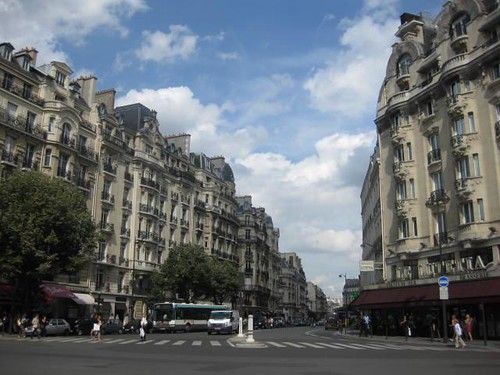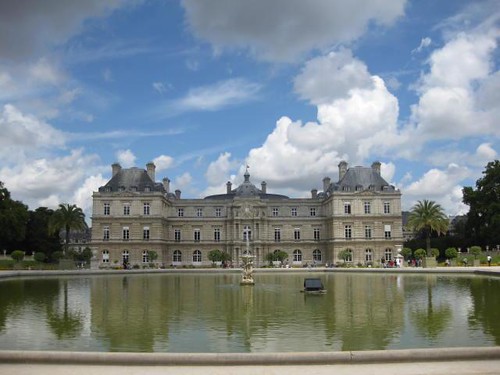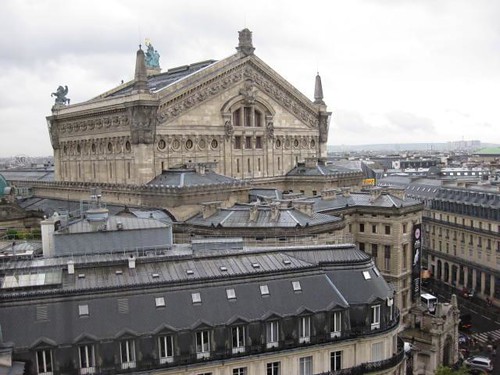Architects of the State: Rise and Fall of the Beaux Arts – 1
1814 – 1872: Solid Foundations

The 19th century was a watershed for French Architecture. The catacombs were fully excavated. The controversial architect Viollet le Duc restored Notre Dame Cathedral. And Napoleon III commissioned Baron Hausmann to tear apart the city’s narrow alleyways and pave grand boulevards. The 19th century also produced the finest buildings of the Ecole des Beaux Arts, France’s famous (and sometimes infamous) school of Architecture.
Many of Paris’ apartments were built by graduates of the Ecole. The houses above demonstrate the principles of the Beaux Arts style. It combined classical era design principles such as rounded arches, classical columns and extravagant decoration with exciting new engineering techniques – no ancient Roman houses stood eight stories tall. Beaux Arts provides Paris’ distinctive look, but in the 19th century, Beaux Arts was not simply an aesthetic. It was the architectural language of the ever changing French state.

The Ecole had taught Architecture since before the fall of the Ancien Regime. But it was shut down in the revolution of 1792, and only opened its doors again after the restoration of the French monarchy in 1814. The Ecole trained young architects strictly in Classical design, as shown by this early 19th century restoration: the Palais du Luxembourg (above). The palace was originally Gothic – note the steep roof, narrow windows and tall chimneys – but the base of the facade was redecorated with rounded classical arches, and classical columns now adorn the entry. This early work of the Ecole is a pretty conservative update to a medieval building. But as power shifted in France, the Ecole moved beyond classical imitation.

After the monarchy was toppled in 1848, France experienced a brief Second Republic, followed by a Second Empire headed by Napoleon III, Napoleon Bonaparte’s nephew. Napoleon III transformed Parisian Architecture, modeling the capital of his new Empire after Imperial Rome. In 1852, he commissioned two graduates of the Ecole des Beaux Arts to resurrect the Louvre (above), a medieval palace in the heart of Paris that housed the French art collection.The new building added sumptuous classical decoration, such as the double ionic pillars beside these windows – note that the top row of pillars does not really support anything!

By mid century, Beaux Arts style was the language of French civic architecture. The Palais de Challiot, the Pont Alexandre III and, most famously, the Garnier Opera house (above) proudly wore the motifs of the Ecole. The Opera house is classical: it’s symmetrical, pillared and beautifully decorated. But it also shows off some of the new engineering feats of the 19th century. The central roof is over seven stories tall, and exists purely so that sets could be raised up above the three story high Opera house stage.

Inside, the Opera house is as lavishly decorated as any Roman temple – it is lit by dozens of chandeliers and every surface is densely populated with figures representing theatrical concepts. The Opera house was first commissioned by the Empire in 1858, but was not finished until 1875. When looking at the complexity involved in its design, we can understand why!

By the middle of the 19th century, the Beaux Arts style was firmly embedded as the civic style in Paris. In adorned libraries, theatres and monuments, and inevitably, Beaux Arts decor covered the apartments of the Emperor Napoleon III (above, as preserved in the Louvre). These extraordinary public buildings not only demonstrate the Ecole’s obsession with ornament and design, but also France’s extraordinary wealth and power in the mid 19th century. You would never guess that this was also one of the most turbulent political periods in French history.
Read the Episode 2 of Architects of the State: Rise and Fall of the Beaux Arts, ‘1872 and beyond: Stress Fractures’, here.
Thank you Thomas Harvey for this insightful guest post. Thomas is a Melbourne based architecture student who was recently impressed by what he saw on his first trip to France.







Merci pour votre article. C’est très intéressant !